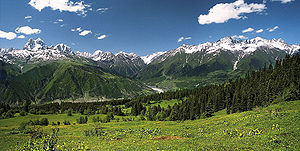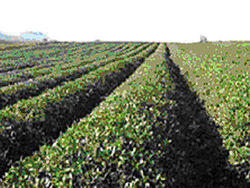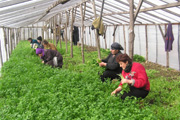.gif)
Agriculture in Georgia (country)
Encyclopedia

Georgia (country)
Georgia is a sovereign state in the Caucasus region of Eurasia. Located at the crossroads of Western Asia and Eastern Europe, it is bounded to the west by the Black Sea, to the north by Russia, to the southwest by Turkey, to the south by Armenia, and to the southeast by Azerbaijan. The capital of...
’s climate
Climate
Climate encompasses the statistics of temperature, humidity, atmospheric pressure, wind, rainfall, atmospheric particle count and other meteorological elemental measurements in a given region over long periods...
and soil
Soil
Soil is a natural body consisting of layers of mineral constituents of variable thicknesses, which differ from the parent materials in their morphological, physical, chemical, and mineralogical characteristics...
have made agriculture one of its most productive economic sectors; the 18 percent of Georgian land that is arable provided 32 percent of the republic's NMP in 1990. In the Soviet period, swampy areas in the west were drained and arid regions in the east were salvaged by a complex irrigation
Irrigation
Irrigation may be defined as the science of artificial application of water to the land or soil. It is used to assist in the growing of agricultural crops, maintenance of landscapes, and revegetation of disturbed soils in dry areas and during periods of inadequate rainfall...
system, allowing Georgian agriculture to expand production tenfold between 1918 and 1980. Production was hindered in the Soviet
Soviet Union
The Soviet Union , officially the Union of Soviet Socialist Republics , was a constitutionally socialist state that existed in Eurasia between 1922 and 1991....
period, however, by the misallocation of agricultural land such as the assignment of prime grain fields to tea cultivation and excessive specialization. Georgia’s emphasis on labor-intensive crops such as tea
Tea
Tea is an aromatic beverage prepared by adding cured leaves of the Camellia sinensis plant to hot water. The term also refers to the plant itself. After water, tea is the most widely consumed beverage in the world...
and grape
Grape
A grape is a non-climacteric fruit, specifically a berry, that grows on the perennial and deciduous woody vines of the genus Vitis. Grapes can be eaten raw or they can be used for making jam, juice, jelly, vinegar, wine, grape seed extracts, raisins, molasses and grape seed oil. Grapes are also...
s kept the rural work force at an unsatisfactory level of productivity. Some 25 percent of the Georgian work force was engaged in agriculture in 1990; 37 percent had been so engaged in 1970. In the spring of 1993, sowing of spring crops was reduced by onethird on state land and by a substantial amount on private land as well because of fuel and equipment shortages. For the first half of 1993, overall agricultural production was 35 percent less than for the same period of 1992.
Crops



Orchard
An orchard is an intentional planting of trees or shrubs that is maintained for food production. Orchards comprise fruit or nut-producing trees which are grown for commercial production. Orchards are also sometimes a feature of large gardens, where they serve an aesthetic as well as a productive...
s, vineyard
Vineyard
A vineyard is a plantation of grape-bearing vines, grown mainly for winemaking, but also raisins, table grapes and non-alcoholic grape juice...
s, and tea plantations, was dedicated to grains. Within that category, corn
Maize
Maize known in many English-speaking countries as corn or mielie/mealie, is a grain domesticated by indigenous peoples in Mesoamerica in prehistoric times. The leafy stalk produces ears which contain seeds called kernels. Though technically a grain, maize kernels are used in cooking as a vegetable...
grew on 40 percent of the land, and winter wheat on 37 percent. The second most important agricultural product is wine. Georgia has one of the world's oldest and finest winemaking
Georgian wine
Georgia is one of the oldest wine producing regions of the world. The fertile valleys of the South Caucasus, which Georgia straddles, are believed by many archaeologists to be the source of the world's first cultivated grapevines and neolithic wine production, over 8,000 years ago...
traditions; archeological findings indicate that wine was being made in Georgia as early as 300 B.C. Some forty major wineries were operating in 1990, and about 500 types of local wines are made. The center of the wine industry is Kakhetia in eastern Georgia. Georgia is also known for the high quality of its mineral waters for example Borjomi
Borjomi (water)
Borjomi is a brand of naturally carbonated mineral water from springs in the Borjomi Gorge of central Georgia. The artesian springs in the valley are fed by water that filters from glaciers covering the peaks of the Bakuriani mountains at altitudes of up to...
.
Other important crops are tea, citrus fruits, and noncitrus fruits, which account for 18.3 percent, 7.7 percent, and 8.4 percent of Georgia's agricultural output, respectively. Cultivation of tea and citrus fruit is confined to the western coastal area. Tea accounts for 36 percent of the output of the large food-processing industry, although the quality of Georgian tea dropped perceptibly under Soviet management in the 1970s and 1980s. Animal husbandry, mainly the keeping of cattle, pigs, and sheep, accounts for about 25 percent of Georgia's agricultural output, although high density and low mechanization have hindered efficiency.
Until 1991 other Soviet republics bought 95 percent of Georgia's processed tea, 62 percent of its wine, and 70 percent of its canned goods. In turn, Georgia depended on Russia for 75 percent of its grain. One-third of Georgia's meat and 60 percent of its dairy products were supplied from outside the republic. Failure to adjust these relationships contributed to Georgia's food crises in the early 1990s.
Land distribution
During the Soviet era, agriculture was characterized by absolute state ownership of all agricultural land and concentration of production in large-scale collective farmsKolkhoz
A kolkhoz , plural kolkhozy, was a form of collective farming in the Soviet Union that existed along with state farms . The word is a contraction of коллекти́вное хозя́йство, or "collective farm", while sovkhoz is a contraction of советское хозяйство...
, which averaged 428 hectares in size. When Georgia became independent after the dissolution of the Soviet Union
Dissolution of the Soviet Union
The dissolution of the Soviet Union was the disintegration of the federal political structures and central government of the Union of Soviet Socialist Republics , resulting in the independence of all fifteen republics of the Soviet Union between March 11, 1990 and December 25, 1991...
in the end of 1991, the entire country was in total disarray facing a bitter civil war. Georgian agriculture collapsed, and the land held by large collective farms was quickly distributed to rural households in an attempt to avoid famine. This desperate goal was achieved as Georgian agriculture quickly recovered in 1993-95. The recovery raised the volume of agricultural production in recent years by 25%-30% above its lowest level in 1993, yet the initial collapse was so dramatic that the agricultural output today is still 40% below what it was in 1990.

Household plot
Household plot is a legally defined farm type in all former socialist countries in CIS and CEE. This is a small plot of land attached to a rural residence. The household plot is primarily cultivated for subsistence and its traditional purpose since the Soviet times has been to provide the family...
, producing crops and livestock on small land plots allocated to rural residents and town dwellers in lifetime inheritable possession. In 1990, according to official statistics, the private sector contributed 46% of gross agricultural output, and private productivity averaged about twice that of the state farms.
As was the case with enterprise privatization, President Gamsakhurdia
Zviad Gamsakhurdia
Zviad Gamsakhurdia was a dissident, scientist and writer, who became the first democratically elected President of the Republic of Georgia in the post-Soviet era...
postponed systematic land reform because he feared that local mafias would dominate the redistribution process. But within weeks of his ouster in early 1992, the new government issued a land reform
Land reform
[Image:Jakarta farmers protest23.jpg|300px|thumb|right|Farmers protesting for Land Reform in Indonesia]Land reform involves the changing of laws, regulations or customs regarding land ownership. Land reform may consist of a government-initiated or government-backed property redistribution,...
resolution providing land grants of one-half hectare to individuals with the stipulation that the land be farmed. Commissions were established in each village to inventory land parcels and identify those to be privatized. Limitations were placed on what the new "owners" could do with their land, and would-be private farmers faced serious problems in obtaining seeds, fertilizer, and equipment. By the end of 1993, over half the cultivated land was in private hands. Small plots were given free to city dwellers to relieve the acute food shortage that year.
Georgia completely individualized its agriculture as early as 1992-93. The individual sector in Georgia currently produces almost 100% of agricultural output, up from 40% before 1990. The shift of production to the individual sector is a reflection of the dramatic increase in the land holdings of rural households. Prior to 1990, only 7% of agricultural land was individual use. A decade later, in 2000, 37% of agricultural land (or more than 70% of arable land) is used by individual farmers.
The universality of land distribution to rural families produced relatively small holdings. Thus, the average size of an individual farm in Georgia is 0.96 hectares and only 5% of farms are larger than 2 hectares.
Size distribution of individual farms in Georgia (early 2000s)
| Farm size | Percent of individual farms |
|---|---|
| Up to 0.5 ha | 22.1 |
| 0.5-1 ha | 29.7 |
| 1-2 ha | 43.6 |
| More than 2 ha | 4.6 |
| Mean size | 0.96 ha |

